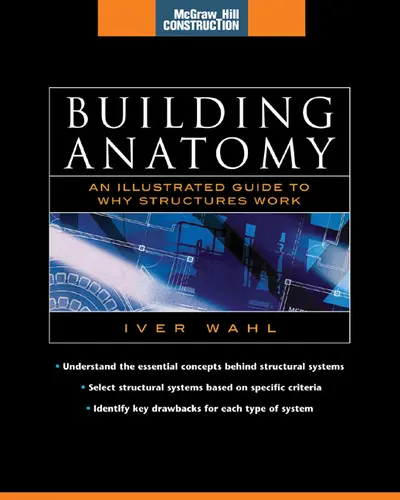My Account Details

ISBN10: 0071432132 | ISBN13: 9780071432139

Step 1 . Download Adobe Digital Editions to your PC or Mac desktop/laptop.
Step 2. Register and authorize your Adobe ID (optional). To access your eBook on multiple devices, first create an Adobe ID at account.adobe.com. Then, open Adobe Digital Editions, go to the Help menu, and select "Authorize Computer" to link your Adobe ID.
Step 3. Open Your eBook. Use Adobe Digital Editions to open the file. If the eBook doesn’t open, contact customer service for assistance.
Publisher's Note: Products purchased from Third Party sellers are not guaranteed by the publisher for quality, authenticity, or access to any online entitlements included with the product.
ELIMINATE COSTLY AND POTENTIALLY DISASTEROUS CONCEPUTAL ERRORS IN YOUR NEXT STRUCTURAL DESIGN
Make sure your next building project is free of the conceptual errors that can cause structural failure with McGraw Hill's Building Anatomy: An Illustrated Guide to How Structures Work.
Packed with a wealth of informative diagrams and illustrations, this essential volume drills deep into the concepts behind structural systems to give you a critical understanding of how they work. From potential loads, load combinations, and superstructure to lateral support systems, foundations, and site soil and geology, Building Anatomy can help you design structures that will stand the test of time.
Written in clear, easy-to-understand language by an award-winning architect and professor, Building Anatomy delivers easy access to critical information, to help you:
- Select structural systems based on the pros and cons of each system
- Size and arrange major structural components
- Identify concerns for each type of structural system
- Anticipate probable failure scenarios
- Explain each system's behavior under loads such as seismic and wind
- Understand construction issues encountered during fabrication and erection of each structure type
- And more!
With its critical information, comprehensive coverage, and indispensable illustrations, Building Anatomy delivers the nuts-and-bolts guidance you need to avoid conceptual mistakes during structural design. You can't afford to work without it!
Chapter 1: ProcessChapter 2: OverviewChapter 3: Structural FailuresChapter 4: LoadsChapter 5: Lateral SupportChapter 6: Geology and SoilsChapter 7: FoundationsChapter 8: Cable SystemsChapter 9: ArchesChapter 10: Post and BeamChapter 11: Rigid FramesChapter 12: Slab & Bearing WallsChapter 13: TrussesChapter 14: Space FrameChapter 15: Folded PlatesChapter 16: VaultsChapter 17: DomesChapter 18: ShellsChapter 19: TentsChapter 20: PneumaticsChapter 21: Structural CreativityChapter 22: Quality Assurance
Chapter 3: Structural FailuresChapter 4: LoadsChapter 5: Lateral SupportChapter 6: Geology and SoilsChapter 7: FoundationsChapter 8: Cable SystemsChapter 9: ArchesChapter 10: Post and BeamChapter 11: Rigid FramesChapter 12: Slab & Bearing WallsChapter 13: TrussesChapter 14: Space FrameChapter 15: Folded PlatesChapter 16: VaultsChapter 17: DomesChapter 18: ShellsChapter 19: TentsChapter 20: PneumaticsChapter 21: Structural CreativityChapter 22: Quality Assurance
Chapter 5: Lateral SupportChapter 6: Geology and SoilsChapter 7: FoundationsChapter 8: Cable SystemsChapter 9: ArchesChapter 10: Post and BeamChapter 11: Rigid FramesChapter 12: Slab & Bearing WallsChapter 13: TrussesChapter 14: Space FrameChapter 15: Folded PlatesChapter 16: VaultsChapter 17: DomesChapter 18: ShellsChapter 19: TentsChapter 20: PneumaticsChapter 21: Structural CreativityChapter 22: Quality Assurance
Chapter 7: FoundationsChapter 8: Cable SystemsChapter 9: ArchesChapter 10: Post and BeamChapter 11: Rigid FramesChapter 12: Slab & Bearing WallsChapter 13: TrussesChapter 14: Space FrameChapter 15: Folded PlatesChapter 16: VaultsChapter 17: DomesChapter 18: ShellsChapter 19: TentsChapter 20: PneumaticsChapter 21: Structural CreativityChapter 22: Quality Assurance
Chapter 9: ArchesChapter 10: Post and BeamChapter 11: Rigid FramesChapter 12: Slab & Bearing WallsChapter 13: TrussesChapter 14: Space FrameChapter 15: Folded PlatesChapter 16: VaultsChapter 17: DomesChapter 18: ShellsChapter 19: TentsChapter 20: PneumaticsChapter 21: Structural CreativityChapter 22: Quality Assurance
Chapter 11: Rigid FramesChapter 12: Slab & Bearing WallsChapter 13: TrussesChapter 14: Space FrameChapter 15: Folded PlatesChapter 16: VaultsChapter 17: DomesChapter 18: ShellsChapter 19: TentsChapter 20: PneumaticsChapter 21: Structural CreativityChapter 22: Quality Assurance
Chapter 13: TrussesChapter 14: Space FrameChapter 15: Folded PlatesChapter 16: VaultsChapter 17: DomesChapter 18: ShellsChapter 19: TentsChapter 20: PneumaticsChapter 21: Structural CreativityChapter 22: Quality Assurance
Chapter 15: Folded PlatesChapter 16: VaultsChapter 17: DomesChapter 18: ShellsChapter 19: TentsChapter 20: PneumaticsChapter 21: Structural CreativityChapter 22: Quality Assurance
Chapter 17: DomesChapter 18: ShellsChapter 19: TentsChapter 20: PneumaticsChapter 21: Structural CreativityChapter 22: Quality Assurance
Chapter 19: TentsChapter 20: PneumaticsChapter 21: Structural CreativityChapter 22: Quality Assurance
Chapter 21: Structural CreativityChapter 22: Quality Assurance
Need support? We're here to help - Get real-world support and resources every step of the way.